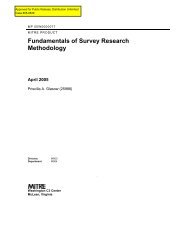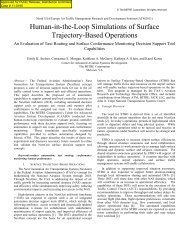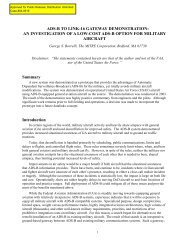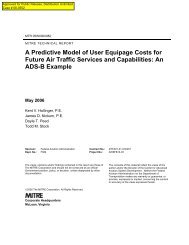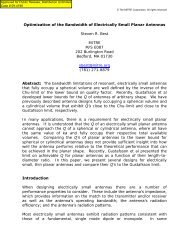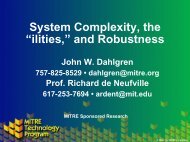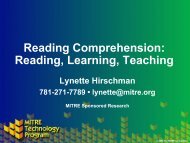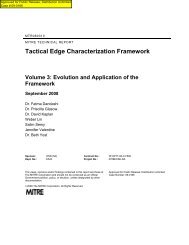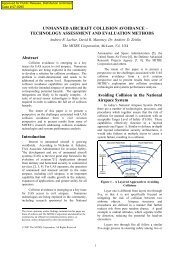A “Community of Interest” Approach to Data Interoperability - Mitre
A “Community of Interest” Approach to Data Interoperability - Mitre
A “Community of Interest” Approach to Data Interoperability - Mitre
You also want an ePaper? Increase the reach of your titles
YUMPU automatically turns print PDFs into web optimized ePapers that Google loves.
In: Federal <strong>Data</strong>base Colloquium ’01, San Diego, August 2001.<br />
A <strong>“Community</strong> <strong>of</strong> <strong>Interest”</strong> <strong>Approach</strong> <strong>to</strong> <strong>Data</strong> <strong>Interoperability</strong><br />
Scott A. Renner, Ph.D., Member, AFCEA<br />
The MITRE Corporation<br />
201 Burling<strong>to</strong>n Ave., MS B265<br />
Bedford, MA 01730, USA<br />
(781) 271-8625<br />
sar@mitre.org<br />
Abstract<br />
Existing data administration policy in the DoD has produced good results in some pockets, but has not delivered<br />
data interoperability for the enterprise as a whole. In this paper we present a concept <strong>of</strong> operations for a<br />
different approach <strong>to</strong> data interoperability, one based around the notion <strong>of</strong> “communities <strong>of</strong> interest”. This approach<br />
corrects the shortcomings <strong>of</strong> the current regime in three ways: First, it does not assume a single monolithic<br />
data standard. Instead, we work <strong>to</strong>ward data interoperability within separate communities <strong>of</strong> interest. These<br />
groups serve a knowledge management purpose: they extract the shared knowledge necessary for data<br />
interoperability from the larger community, then make this knowledge explicit, and finally help <strong>to</strong> transfer that<br />
knowledge back in<strong>to</strong> the whole community. Second, our approach captures knowledge at more than one level <strong>of</strong><br />
abstraction. Our approach will produce higher-level definitions that can support interoperability in architecture<br />
descriptions and information retrieval “semantic tags” in addition <strong>to</strong> the current implementation-level data standards.<br />
Finally, our approach can become part <strong>of</strong> the system acquisition process, giving both better incentives for<br />
program <strong>of</strong>fices <strong>to</strong> participate, and better metrics for measuring their results.<br />
Key words - Community <strong>of</strong> interest, data interoperability, knowledge management<br />
1. <strong>Data</strong> interoperability is a knowledge management problem<br />
<strong>Data</strong> interoperability is a key element in the Joint Vision 2020 goal <strong>of</strong> information superiority [2]. But we still do<br />
not have a workable plan for achieving DoD-wide data interoperability. This paper is intended <strong>to</strong> describe the principles<br />
on which such a plan might be implemented.<br />
We define data interoperability as the ability <strong>to</strong> correctly interpret data that crosses system or organizational<br />
boundaries. The key points are illustrated below in Figure 1. We assume that the people on the left have information<br />
needed by the people on the right, and that data in one system is accessible <strong>to</strong> the other. Information can flow (and<br />
we have data interoperability) if and only if the receiving system and users properly understand the data they receive.<br />
Clearly, data interoperability is only one aspect <strong>of</strong> the overall interoperability problem. The left-hand side<br />
might not ever have the information needed by the right-hand side. Or it might be impossible <strong>to</strong> get data from one<br />
system <strong>to</strong> another (because <strong>of</strong> incompatible radios, physical connec<strong>to</strong>rs that don’t fit, etc.) While those would be<br />
interoperability problems, they would not be data interoperability problems.<br />
Two things must happen before two systems or organizations can understand each other’s data. First, the people<br />
involved must identify a matching real-world thing <strong>of</strong> mutual interest. (All data describes some thing <strong>of</strong> interest. You<br />
can’t meaningfully exchange data unless it describes the same thing.) We call this step establishing a semantic<br />
match. Second, they must arrange <strong>to</strong> eliminate or otherwise deal with the differences in the name, structure, and representation<br />
in the data models they use <strong>to</strong> describe this real-world thing. For example, if you measure a certain<br />
distance in miles, but I expect distances measured in kilometers, then the appropriate conversion must be applied <strong>to</strong><br />
the data before I can properly use and understand it. This second step is coping with representation mismatch.<br />
(More details, with examples, can be found in [6].)
Deciders<br />
use<br />
systems<br />
information<br />
Deciders exchange<br />
information<br />
Systems exchange data<br />
data<br />
Source System A Receiver System B<br />
Figure 1: <strong>Data</strong> interoperability<br />
2<br />
Deciders<br />
use<br />
systems<br />
In this paper we focus on the semantic match problem. It is by far the most challenging <strong>of</strong> the two. Representation<br />
mismatch problems can have au<strong>to</strong>mated solutions, either through hand-written translation s<strong>of</strong>tware or data<br />
mediation <strong>to</strong>ols. But there is never going <strong>to</strong> be an au<strong>to</strong>mated approach <strong>to</strong> the problem <strong>of</strong> semantic matching, because<br />
the solution takes place inside the human mind. That is, for every data interoperability success, there are at least two<br />
people with a shared understanding <strong>of</strong> the exchanged data. These people may be users who look at the data presented<br />
<strong>to</strong> them, or they may be programmers who decide what systems will do with the data they process. Either<br />
way, these are the people who know what the data should mean. If the data they receive does not conform <strong>to</strong> the<br />
definitions they know and expect, the result will be an error, not interoperability.<br />
Crucially, what must be shared is knowledge, which is inside human minds, and not merely written definitions,<br />
which can be captured in words and paragraphs. For example, you and I might both be satisfied with the definition<br />
“an aircraft is a vehicle that moves through the air.” But if in your world all aircraft happen <strong>to</strong> have a fixed wing and<br />
at least one engine, while my world includes free balloons and helicopters, then this difference in tacit knowledge is<br />
likely <strong>to</strong> cause some interoperability problems even though we are using the exact same explicit definition. Conversely,<br />
the developers on my s<strong>of</strong>tware project might arrive at a common understanding <strong>of</strong> our data through<br />
conversation, without any written definitions at all. Shared knowledge, not shared documentation, is what counts.<br />
Common explicit definitions are <strong>of</strong> course useful – we are hardly arguing in favor <strong>of</strong> undocumented s<strong>of</strong>tware – but<br />
they are neither necessary nor sufficient.<br />
The semantic part <strong>of</strong> data interoperability is therefore a knowledge management problem: How do we arrange for<br />
the right people <strong>to</strong> have the right (shared) knowledge about what the data means? Au<strong>to</strong>mated <strong>to</strong>ols can help solve<br />
this problem. They can never make it go away.<br />
It is instructive <strong>to</strong> look at the places where shared semantic knowledge is important and at the roles <strong>of</strong> the people<br />
who need it. Here are the most important cases:<br />
• Users need <strong>to</strong> understand the meaning <strong>of</strong> the data presented <strong>to</strong> them. Programmers need <strong>to</strong> understand the<br />
data their programs will manipulate. These people must have a shared understanding <strong>of</strong> the runtime instance<br />
data values. (This is the most common case, the one that everyone thinks <strong>of</strong> first.)<br />
• Architects building products from the C4ISR Architecture Framework [1] need a common vocabulary for representing<br />
information exchanges. These architecture products include abstract descriptions <strong>of</strong> the instance<br />
data that will be exchanged between executing systems. That is, they need <strong>to</strong> describe what information will<br />
be exchanged, but not necessarily how it will be represented. Without a shared understanding <strong>of</strong> the information<br />
described in operational and system architectures, it will be impossible <strong>to</strong> relate architectures developed<br />
by separate teams, or <strong>to</strong> “roll them up” in<strong>to</strong> an integrated view – or even <strong>to</strong> be confident that one product will<br />
convey the same meaning <strong>to</strong> any two readers.<br />
• Information dissemination relies on commonly-unders<strong>to</strong>od metadata “tags” <strong>to</strong> distribute information products<br />
from producer <strong>to</strong> consumers. For example, one consumer might state in his pr<strong>of</strong>ile that he wants<br />
information about “surface naval ships”. He then receives documents that are so marked by their producers.
This depends on a shared classification taxonomy – it won’t work unless producers and consumers have the<br />
same understanding <strong>of</strong> “surface”, “naval”, and “ship”.<br />
• The semantic web [4] is a plan <strong>to</strong> extend the existing Web by adding machine-processable semantic metadata<br />
<strong>to</strong> web pages. S<strong>of</strong>tware agents can use this metadata <strong>to</strong> “understand” the information and/or services provided<br />
by a web resource and then <strong>to</strong> act on our behalf: reserve us a rental car, change a doc<strong>to</strong>r’s<br />
appointment, etc. But unless the people involved (the end user, the agent programmer, the resource provider)<br />
have a shared understanding <strong>of</strong> this semantic metadata, we shouldn’t expect these smart agents <strong>to</strong> actually<br />
do what the user wants done.<br />
These people do not all need precisely the same knowledge. For example, s<strong>of</strong>tware programmers (<strong>of</strong> a web agent<br />
or <strong>of</strong> a traditional application) need more detailed knowledge than s<strong>of</strong>tware architects. But people in these different<br />
roles do not need completely different knowledge, either. Clearly the sort <strong>of</strong> high-level “what is an aircraft?” definition<br />
is useful in every role. The knowledge needed by architects (what information do these systems exchange?)<br />
should be an abstraction <strong>of</strong> the knowledge needed by the system developers (exactly what data are we passing <strong>to</strong><br />
each other?). Figure 2 shows different roles and the level <strong>of</strong> detail and assurance they require. The determining fac<strong>to</strong>r<br />
is the location <strong>of</strong> the person who does the understanding: end users, who can examine instance data at runtime, need<br />
less than programmers, who cannot.<br />
Agentbased<br />
computing Simulation<br />
Formal, detailed,<br />
complex models<br />
(process and data)<br />
<strong>Data</strong><br />
Sharing / <strong>Data</strong><br />
<strong>Interoperability</strong><br />
3<br />
Architecture<br />
descriptions<br />
(JBI force<br />
templates)<br />
Dissemination<br />
management<br />
more detail less detail<br />
Digital<br />
libraries<br />
Simple, informal<br />
concept definitions<br />
(taxonomies)<br />
Figure 2: Level <strong>of</strong> detail and assurance needed for different purposes<br />
How can we explicitly capture this shared knowledge in a way that maintains these relations without requiring<br />
people <strong>to</strong> learn details they do not need? In [7] we suggest organizing semantic metadata in<strong>to</strong> the following layers:<br />
• On<strong>to</strong>logies are organized collections <strong>of</strong> definitions, including relations between the defined terms. In its simplest<br />
form an on<strong>to</strong>logy is a dictionary <strong>of</strong> terms. <strong>Data</strong> models may specify the meaning <strong>of</strong> their entities and<br />
attributes by reference <strong>to</strong> the definitions in the on<strong>to</strong>logy. (An on<strong>to</strong>logy is not itself really a model; instead, it<br />
defines the universe <strong>of</strong> things that can be included in a data model.)<br />
• Abstract schemas define information without specifying a particular data representation. They allow application<br />
developers <strong>to</strong> establish a semantic match with a database (or second application). Abstract models are<br />
sometimes called conceptual data models<br />
• In a concrete schema, all <strong>of</strong> the attributes are fully-defined as implementable data types. A concrete schema<br />
defines everything the application developer needs <strong>to</strong> know about the data when interfacing with a database<br />
(or second application): a complete description <strong>of</strong> the names, structures, and representations <strong>of</strong> the data. A<br />
fully-attributed, normalized logical data model is a concrete model. Standard message formats (e.g. the Air<br />
Tasking Order) are also concrete data models.<br />
Organizing semantic metadata in this fashion preserves the connections between related knowledge, because<br />
metadata in one layer points <strong>to</strong> metadata in a higher layer <strong>to</strong> specify its meaning. It helps with the level-<strong>of</strong>-detail<br />
problem, because people need not learn facts in the lower levels if they do not need them. We still have a big problem<br />
with the scope <strong>of</strong> knowledge required. It is impossible for anyone <strong>to</strong> know all <strong>of</strong> the definitions that are required<br />
for everyone <strong>to</strong> exchange data. That is, the shared knowledge required for the union <strong>of</strong> all data exchanges is <strong>to</strong>o large
<strong>to</strong> fit inside any one person’s head. We must partition semantic knowledge in<strong>to</strong> smaller, more tractable packages.<br />
The mechanism for doing this is the subject <strong>of</strong> the next section.<br />
2. Communities <strong>of</strong> interest are a knowledge management solution<br />
<strong>Data</strong> interoperability poses a knowledge management problem: how do you get the needed semantic knowledge<br />
in<strong>to</strong> the people that must understand the exchanged data? The community <strong>of</strong> interest concept is the knowledge<br />
management solution we propose. We define a community <strong>of</strong> interest (COI) as the collection <strong>of</strong> people that are concerned<br />
with the exchange <strong>of</strong> information in some subject area. The community is made up <strong>of</strong> the users/opera<strong>to</strong>rs that<br />
actually participate in the information exchange; the system builders that develop computer systems for these users;<br />
and the functional proponents that define requirements and acquire systems on behalf <strong>of</strong> the users. The subject area<br />
is the COI domain – whatever the people in the COI need <strong>to</strong> communicate about. And in order for the systems and<br />
organizations <strong>to</strong> communicate – <strong>to</strong> have data interoperability – the people in the COI must all know and understand<br />
the consensus definitions for the data they will exchange.<br />
Because we assert a priori that the people in a COI need <strong>to</strong> communicate with each other, we know that it must be<br />
possible for them <strong>to</strong> agree on consensus definitions for the things <strong>of</strong> mutual interest. But it takes hard work <strong>to</strong> establish<br />
what these things are, and what the agreed definitions will be. This work is the function <strong>of</strong> the COI data<br />
panel. The people on the data panel are drawn from the COI. Their job is <strong>to</strong> represent every part <strong>of</strong> the COI, determine<br />
where the data interests <strong>of</strong> these parts intersect, and then produce the shared definitions for the union <strong>of</strong> these<br />
intersections. In their job the data panel is performing a knowledge management task. First, the data panel extracts<br />
the shared knowledge necessary for data interoperability from the larger community, it then makes this knowledge<br />
explicit, and finally it works <strong>to</strong> transfer that knowledge back in<strong>to</strong> the whole community. The data panel’s job is done<br />
when everyone in the COI knows the definitions they must have in common in order <strong>to</strong> exchange information.<br />
2.1 What do COI data panels do?<br />
The main task <strong>of</strong> the data panel is <strong>to</strong> produce and maintain the common data representation (CDR) for the COI<br />
domain. The CDR is the explicit representation <strong>of</strong> the COI’s shared semantic knowledge. It will be organized in<strong>to</strong> on<strong>to</strong>logy,<br />
abstract schema, and concrete schema as described above. We expect the data panel <strong>to</strong> produce reference<br />
data sets; that is, the values <strong>of</strong> coded fields and their meanings. They may also produce business rules (constraints<br />
on the data values) and process models (which describe how data is used).<br />
The process <strong>of</strong> building the CDR is not vastly different from the collaborative data modeling sessions used in the<br />
present data administration regime. There are three important differences: The panel will produce more than standard<br />
data elements and models and other concrete schema artifacts; it will also build on<strong>to</strong>logies and abstract schemas.<br />
The panel will focus on exchanged data, not all data, and will consider cost/benefit when choosing the exchanged<br />
data that will be modeled first. Finally, existing systems are not required <strong>to</strong> change their internal data representation<br />
<strong>to</strong> conform <strong>to</strong> the CDR. Instead the individual program managers will make that decision on a cost/benefit basis. [5]<br />
contains a description <strong>of</strong> a process that could be used <strong>to</strong> build CDRs, plus more discussion <strong>of</strong> the three differences<br />
above and the advantages they bring. Also, the Health Level Seven (HL7) consortium has developed a detailed<br />
modeling methodology that could be adapted <strong>to</strong> building CDR for COIs [3].<br />
2.2 How are COI data panels formed?<br />
The process always begins when someone identifies the need for a new data panel. This can happen bot<strong>to</strong>m-up,<br />
when separate organizations realize that <strong>to</strong>gether they form a COI and need a data panel <strong>to</strong> construct their consensus<br />
CDR. It can also happen <strong>to</strong>p-down, by direction, without waiting for organizations A, B, and C <strong>to</strong> realize (or admit)<br />
that they need <strong>to</strong> cooperate on a COI data panel. No matter how the process begins, the next step is always <strong>to</strong> prepare<br />
a draft charter for the COI data panel. This work will be led by the proposing organization. The following issues<br />
must be considered in preparing the draft charter:<br />
• The proper scope <strong>of</strong> the new COI (the people) and <strong>of</strong> the COI domain (the subject matter). This is more an art<br />
than a science. The first principle is that data interoperability problems arise when data crosses system and<br />
organization boundaries. Therefore, useful COIs will also cross these boundaries. A COI completely con-<br />
4
tained within a single organization (or worse, within a single system) would not be worth the bother. Second,<br />
COIs become more valuable as they include more people and cover a larger domain. However, the costs <strong>of</strong><br />
creating/maintaining a COI increases along with its size. Eventually the costs increase faster than the value.<br />
We do not have a hard objective rule for computing the optimum size <strong>of</strong> a COI – consensus among the participants<br />
(is this group getting <strong>to</strong>o big <strong>to</strong> be effective?) is probably the best we can do, at least for now. As a<br />
rule <strong>of</strong> thumb, consider that everyone in the COI ought <strong>to</strong> understand all <strong>of</strong> the definitions in the CDR. When<br />
that seems <strong>to</strong>o hard, consider partitioning the COI in<strong>to</strong> smaller specialized domains.<br />
• The organizations that should belong <strong>to</strong> the COI and be an active part <strong>of</strong> the data panel. (That is, try <strong>to</strong> distinguish<br />
those who want and need <strong>to</strong> build the CDR from those who will simply use it.) This will be an<br />
iterative process; adding an organization <strong>to</strong> the COI may change the domain, which may in turn change the<br />
organizations that should belong.<br />
• The cost and benefit <strong>of</strong> chartering a data panel for the proposed COI. Both <strong>of</strong> these are difficult <strong>to</strong> quantify<br />
exactly. Costs include both the work <strong>of</strong> building the CDR, and <strong>of</strong> transferring the knowledge in the CDR <strong>to</strong><br />
the whole COI. Some benefits are avoided costs elsewhere; e.g. the system interfaces become cheaper <strong>to</strong><br />
build and maintain. Other benefits appear as increased capability.<br />
• Does the proposed COI cover the intersection <strong>of</strong> two or more major existing COIs? Then it must be a substantial<br />
intersection, something worth the overhead <strong>of</strong> a data panel. Be sure there really is a distinct<br />
community <strong>of</strong> people who must work in both domains A and B; be sure the necessary work can’t be done<br />
within the separate A and B panels.<br />
• Is the proposed COI a subset <strong>of</strong> an existing COI? This only makes sense if the smaller subgroup needs a<br />
specialized vocabulary and if it’s <strong>to</strong>o expensive <strong>to</strong> expect everyone in the larger group <strong>to</strong> know this vocabulary.<br />
COI data panels are established when their draft charter is approved by the chartering authority. We suggest that<br />
the service Chief Information Officer (CIO) is the proper authority for those communities that do not cross a service<br />
boundary, and that the DoD CIO is the right authority for communities that include more than one service.<br />
The data panel needs <strong>to</strong> include representatives from every part <strong>of</strong> the COI. When some systems or organizations<br />
are not represented, it is likely that some <strong>of</strong> their knowledge will not be captured by the data panel, or that some <strong>of</strong><br />
the knowledge codified by the panel will not be transferred back in<strong>to</strong> those groups. In either case, data<br />
interoperability with the missing groups will suffer.<br />
Most <strong>of</strong> the people on the panel will be subject matter experts (SMEs) in the COI domain. These, after all, are the<br />
people who possess the knowledge the data panel is trying <strong>to</strong> capture. It is likely that most <strong>of</strong> the SMEs will be functional<br />
proponents. However, because some <strong>of</strong> the knowledge we are trying <strong>to</strong> capture is implementation-level detail,<br />
the data panel will need <strong>to</strong> include SMEs from the system builders. Finally, each data panel will typically need some<br />
people whose expertise is in capturing data definitions, rather than in the COI domain <strong>to</strong> be defined.<br />
Most <strong>of</strong> the work in the data panel will be done by the SMEs drawn from the functional and builder communities,<br />
and so most <strong>of</strong> the costs will be carried by those organizations. Program <strong>of</strong>fices will know the COIs they belong <strong>to</strong>,<br />
and will need <strong>to</strong> include costs <strong>of</strong> participation in their budget. A small part <strong>of</strong> the work should be centrally funded,<br />
and not directly paid for by the participating organizations. We suggest that responsibility for developing and maintaining<br />
the procedures and infrastructure used by the data panels probably belongs <strong>to</strong> the DoD CIO.<br />
3. Incentives and motivation: why this solution will work<br />
Suppose we charter a COI data panel and allow it <strong>to</strong> build the common data representation that captures semantic<br />
knowledge for the COI domain. This by itself doesn’t do any good. We are no closer <strong>to</strong> data interoperability until<br />
this knowledge is acquired by the rest <strong>of</strong> the community and used by system developers <strong>to</strong> implement data exchange.<br />
How can we make that happen? Experience teaches that it is not enough <strong>to</strong> simply give orders <strong>to</strong> the developers.<br />
Instead, we need <strong>to</strong> make COIs part <strong>of</strong> the work process they are already following. We also need <strong>to</strong> show how the<br />
COI process makes it easier for developers <strong>to</strong> satisfy the interoperability requirements they already have.<br />
There are several ways that the COI process can be inserted in<strong>to</strong> the existing system acquisition process. The<br />
following suggestions call for the definitions in a COI’s common data representation <strong>to</strong> be used in products that are<br />
already being created. If a program needs a definition that does not exist in any CDR, then that program has not been<br />
adequately participating in the corresponding COI data panels.<br />
5
• MNS and ORD: At a minimum, we should require each Mission Needs Statement and Operational Requirements<br />
Document <strong>to</strong> specify the list <strong>of</strong> COIs in which that system will participate. (A system which does not<br />
belong <strong>to</strong> any COI is by definition a s<strong>to</strong>vepipe. Who wants <strong>to</strong> fund any more <strong>of</strong> those?) We might also<br />
measure the proportion <strong>of</strong> nouns and verbs in the functional requirements that are defined in the on<strong>to</strong>logies<br />
from the corresponding COIs.<br />
• C4I Support Plan: These are <strong>to</strong>ols for managing implementation issues related <strong>to</strong> C4I infrastructure for a<br />
specific system or program. They may describe information exchange requirements; when they do, these<br />
should be expressed using abstract schemas defined by the relevant COIs.<br />
• Operational and system architectures: All information exchange requirements described in C4ISR Architecture<br />
Framework products should be entirely captured in an abstract schema defined by a COI. The logical<br />
data model (OV-7) should map <strong>to</strong> an abstract or concrete schema defined by a COI.<br />
• <strong>Data</strong> exchange agreements, message formats, and ICDs: All <strong>of</strong> these should map <strong>to</strong> a concrete schema defined<br />
by a COI.<br />
• <strong>Data</strong>base definitions: Definitions <strong>of</strong> the shared portion <strong>of</strong> a physical database model should be drawn from<br />
concrete model defined by the relevant COIs. That is, when you are building a physical database model, you<br />
should define the meaning <strong>of</strong> your data elements using definitions from the COI’s definitions whenever these<br />
are available.<br />
• Semantic tags: The terms used in pr<strong>of</strong>iles for information dissemination should be drawn from an on<strong>to</strong>logy<br />
defined by a COI.<br />
The COI approach can make the developer’s job <strong>of</strong> building interoperable systems easier. To a certain extent the<br />
COI data panels only reorganize work that programs are already performing. Programs already invest much effort in<br />
building interfaces with other systems. Part <strong>of</strong> that work is creating a shared understanding <strong>of</strong> the data <strong>to</strong> be exchanged.<br />
That work is no harder when done in a data panel instead <strong>of</strong> in pairwise interface meetings. <strong>Data</strong> panels<br />
<strong>of</strong>fer the possibility <strong>of</strong> reuse; that is, some <strong>of</strong> the shared semantic knowledge needed <strong>to</strong> interface with system A may<br />
be helpful when interfacing with system B. Finally, parts <strong>of</strong> the CDR produced by the data panels can be used <strong>to</strong> implement<br />
data exchanges with other systems; for example, as inputs <strong>to</strong> a data media<strong>to</strong>r.<br />
4. Conclusion<br />
The hardest part <strong>of</strong> data interoperability is the semantic problem: arranging a shared understanding <strong>of</strong> what the<br />
data means among all the people involved in the data exchange. This same problem occurs when systems share data<br />
through direct database exchange, when systems pass XML documents <strong>to</strong> each other, when separate architecture<br />
teams try <strong>to</strong> integrate their work, and when producers and consumers try <strong>to</strong> use semantic “tags” for information dissemination.<br />
We can approach the semantic problem in all <strong>of</strong> these cases by dividing people in<strong>to</strong> communities <strong>of</strong><br />
interest and making explicit the knowledge each community needs <strong>to</strong> communicate. That will take hard work, but it is<br />
work that would have <strong>to</strong> be done anyway, possibly over and over. By inserting our “community <strong>of</strong> interest” approach<br />
in<strong>to</strong> the normal system acquisition process, we can arrange for that work <strong>to</strong> be done once. The result will be a<br />
data interoperability solution that can work, because it is technically feasible, and will work, because it will actually be<br />
executed by the programs.<br />
References<br />
[1] C4ISR Architecture Framework, version 2.0, December 1997.<br />
http://www.c3i.osd.mil/org/cio/i3/AWG_Digital_Library/pdfdocs/fw.pdf<br />
[2] Department <strong>of</strong> Defense, Joint Chiefs <strong>of</strong> Staff, Joint Vision 2020, June 2000. http://www.dtic.mil/jv2020/jvpub2.htm<br />
[3] G. Beeler et. al., Message Development Framework, Health Level Seven, Inc., 1999.<br />
http://www.hl7.org/Library/mdf99/mdf99.pdf<br />
[4] T. Berners-Lee, J. Hendler and O. Lassila, “The Semantic Web”, Scientific American, May 2001.<br />
http://www.sciam.com/2001/0501issue/0501berners-lee.html<br />
[5] S. Renner and J. Scarano, “Organization, Process, and Technical Foundation for <strong>Data</strong> <strong>Interoperability</strong>”, DoD <strong>Data</strong>base<br />
Colloquium, San Diego, September 1997.<br />
6
[6] S. Renner, A. Rosenthal, and J. Scarano, “<strong>Data</strong> <strong>Interoperability</strong>: Standardization or Mediation”, 1st IEEE Metadata<br />
Conference, Silver Spring, MD, 1996.<br />
http://www.nml.org/resources/misc/metadata/proceedings/renner/data-interop.html<br />
[7] A. Rosenthal, E. Sciore, S. Renner, “Toward Integrated Metadata for the Department <strong>of</strong> Defense”, 2nd IEEE Metadata<br />
Conference, Silver Spring, MD, 1997. http://www.llnl.gov/liv_comp/metadata<br />
Author Biography<br />
Dr. Scott A. Renner is a Principal Scientist in MITRE’s Center for Air Force C2 Systems at Bedford, MA. He has a<br />
Ph.D. in computer science from the University <strong>of</strong> Illinois at Urbana-Champaign. He participated in the USAF<br />
Scientific Advisory Board studies Building the Joint Battlespace Infosphere and <strong>Data</strong>base Migration for Command<br />
and Control, and is a contribu<strong>to</strong>r <strong>to</strong> the DoD-wide <strong>Data</strong> <strong>Interoperability</strong> Rapid Improvement Team.<br />
7



